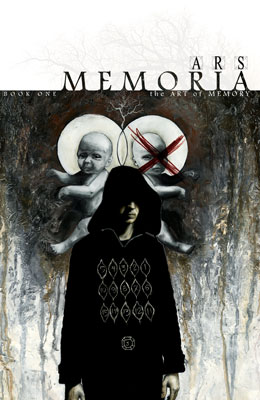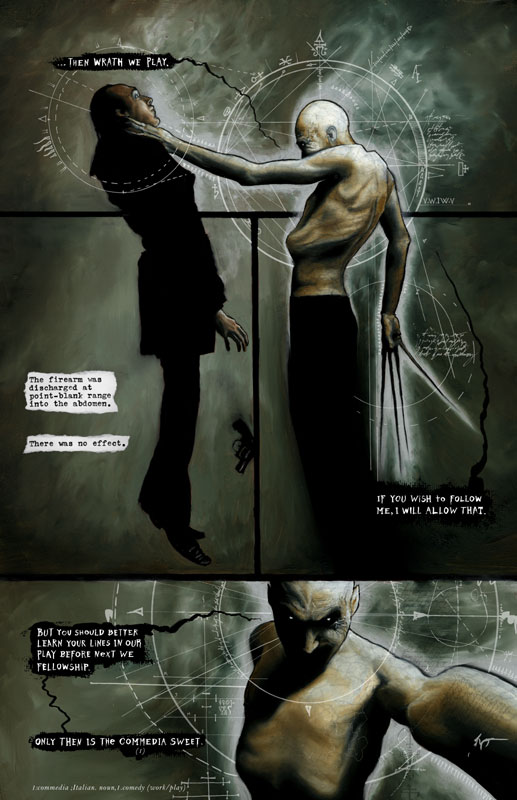- Comics
- Comics Reviews
- Manga
- Comics Reviews
- European Comics
- News
- Comics News
- Press Releases
- Columns
- Spotlight
- Digital Comics
- Webcomics
- Cult Favorite
- Back Issues
- Webcomics
- Movies
- Toys
- Store
- More
- About
By Andy Frisk
July 13, 2009 - 14:00
Menton J. Matthews III’s first foray into graphic novels, Ars Memoria: The Art of Memory Book One, is an interesting work that, at first, appears to be a simple tale of one man’s quest to find his missing twin brother, who was stolen in the night when they were both children. As the book progresses it becomes apparent that there’s much more at work here in theme and meaning than just a simple horror story.

There’s an element of the supernatural, as apparently his brother was taken by a creature that looks like one of Clive Barker’s Cenobites (albeit without the gross wounds). One has to wonder though if “supernatural” is the correct way to describe the events of this work. Augustus Lubert Das, the tale’s protagonist, opens the work by stating to the reader, “I do not like your kind. Yes, the ones that read comics day in and day out, so they can be transported away to a fantasy world. Every creek in a house is a ghost. Every light in the sky is an invader. A wave in a lake is a prehistoric monster. But I need you…” Augustus himself admits that some have called his story “supernatural,” but his dismissal of every “creek in a house” being fancifully thought of as a ghost, etc., causes one to come to the conclusion that what we are about to read should be viewed as myth or, better yet, allegory.
Augustus’ comments to the reader are examples of the ever present, and seemingly necessary, inclusion of meta-fictional elements that many smart, “indie” writers use to advertise just how “smart” they are. In Matthew’s case though, his use of meta-fiction has a meaning that goes beyond being a hallmark of his “indie” cred. We would be wise to remember as we progress through Ars Memoria, Augustus’ distain for comic book readers who want to be “transported away to a fantasy world.” His statement draws attention to the fact that we comic book readers, sometimes all too quickly, dumb down, and want to experience simple escapist fantasy, where Matthews, while using fanciful elements in his graphic novel, will be discussing and exposing us to something much more memorable and realistic, from a philosophical and spiritual sense, than a simple escapist fantasy tale.
Memory and the Art of Memory are key elements of the unfolding tale, obviously, and some quick web based research into the Ars Memoria, or Art of Memory, really opens up the tale, and its artwork. The practice of the Art of Memory involves the use of various techniques such as rhyme, emotional response, gestures, and the like to build up vast amounts of storied memory. Some practitioners of the Art of Memory use diagrams, geometric shapes, and numbers to create images that link to different memorized information. This process is referred to as graphical memory device use.
Architectural memory device use involves the use of memorizing a building, its rooms, and (in advanced instances) items within a room, and then assigning a specific memory to the room or item, the details of which will be triggered by the room or item. To take the idea further though, the Art of Memory can be used to tap into the universal unconscious, as Jung calls it, and even deeper universal and spiritual meanings involving the self, etc. (Maybe “supernatural” is a valid term when examining this story after all?). Various elements of the several types of Ars Memoria are represented visually throughout the book, especially in its artwork. To list them here would rob the reader of the intellectually fun exercise of discovering them for themselves, and potentially unlocking the meaning behind the allegorical ideas of Augustus’ tale.

Beyond the puzzles, references, and clues to the story’s potential meanings or interpretations, which are hidden in the artwork, the artwork itself is as dark and moody as it is good, and it is quite good. Matthew’s chosen style fits the tale very well. His ability as an oil painter is evident. His ability to translate the art of oil painting into the art of creating a graphic novel is accomplished quite well. As for the dark and moody aspects of the art, what mental trip down the dark corridors of one’s halls of memory, especially the halls of fearful or repressed memories, wouldn’t be dark and moody? From a technical standpoint, Matthew’s art is quite accomplished. He creates accurately proportioned geometrical designs, and rigid architecture, while effectively recreating human anatomy, and especially facial expressions, with all of their soft and flexible curves and tones. The book’s visuals are quite striking and interesting.
Overall, Ars Memoria: The Art of Memory Book One is a worthwhile debut from writer/artist Menton J. Matthews III. It will be interesting to see where the tale goes from here, and what secrets are revealed pertaining to Augustus’ “brother,” who might just turn out to be simply another allegorical representation of the “self.” Tim Hall Rudisill, a special advisor and friend of Matthew’s who wrote the book's epilogue, refers to “self” repeatedly in his informative, if somewhat rambling, afterword. Either way, the further into Augustus’ memory we travel the more interesting this tale will become.
For more information visit: www.ars-memoria.com
Rating: 9 /10